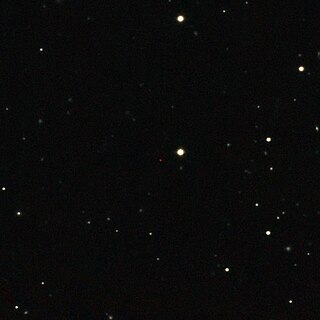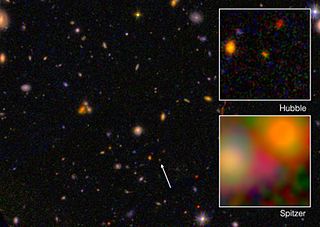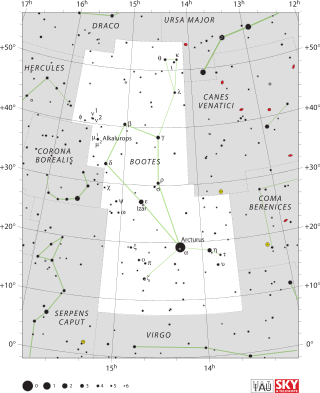Related Research Articles

A black hole is a region of spacetime where gravity is so strong that nothing, including light or other electromagnetic waves, has enough energy to escape it. The theory of general relativity predicts that a sufficiently compact mass can deform spacetime to form a black hole. The boundary of no escape is called the event horizon. Although it has a great effect on the fate and circumstances of an object crossing it, it has no locally detectable features according to general relativity. In many ways, a black hole acts like an ideal black body, as it reflects no light. Moreover, quantum field theory in curved spacetime predicts that event horizons emit Hawking radiation, with the same spectrum as a black body of a temperature inversely proportional to its mass. This temperature is of the order of billionths of a kelvin for stellar black holes, making it essentially impossible to observe directly.

A quasar is an extremely luminous active galactic nucleus (AGN). It is sometimes known as a quasi-stellar object, abbreviated QSO. The emission from an AGN is powered by a supermassive black hole with a mass ranging from millions to tens of billions of solar masses, surrounded by a gaseous accretion disc. Gas in the disc falling towards the black hole heats up and releases energy in the form of electromagnetic radiation. The radiant energy of quasars is enormous; the most powerful quasars have luminosities thousands of times greater than that of a galaxy such as the Milky Way. Quasars are usually categorized as a subclass of the more general category of AGN. The redshifts of quasars are of cosmological origin.
The Schwarzschild radius or the gravitational radius is a physical parameter in the Schwarzschild solution to Einstein's field equations that corresponds to the radius defining the event horizon of a Schwarzschild black hole. It is a characteristic radius associated with any quantity of mass. The Schwarzschild radius was named after the German astronomer Karl Schwarzschild, who calculated this exact solution for the theory of general relativity in 1916.

An elliptical galaxy is a type of galaxy with an approximately ellipsoidal shape and a smooth, nearly featureless image. They are one of the four main classes of galaxy described by Edwin Hubble in his Hubble sequence and 1936 work The Realm of the Nebulae, along with spiral and lenticular galaxies. Elliptical (E) galaxies are, together with lenticular galaxies (S0) with their large-scale disks, and ES galaxies with their intermediate scale disks, a subset of the "early-type" galaxy population.

A supermassive black hole is the largest type of black hole, with its mass being on the order of hundreds of thousands, or millions to billions of times the mass of the Sun (M☉). Black holes are a class of astronomical objects that have undergone gravitational collapse, leaving behind spheroidal regions of space from which nothing can escape, not even light. Observational evidence indicates that almost every large galaxy has a supermassive black hole at its center. For example, the Milky Way galaxy has a supermassive black hole at its center, corresponding to the radio source Sagittarius A*. Accretion of interstellar gas onto supermassive black holes is the process responsible for powering active galactic nuclei (AGNs) and quasars.
In general relativity, a white hole is a hypothetical region of spacetime and singularity that cannot be entered from the outside, although energy-matter, light and information can escape from it. In this sense, it is the reverse of a black hole, from which energy-matter, light and information cannot escape. White holes appear in the theory of eternal black holes. In addition to a black hole region in the future, such a solution of the Einstein field equations has a white hole region in its past. This region does not exist for black holes that have formed through gravitational collapse, however, nor are there any observed physical processes through which a white hole could be formed.

An intermediate-mass black hole (IMBH) is a class of black hole with mass in the range 102–105 solar masses: significantly more than stellar black holes but less than the 105–109 solar mass supermassive black holes. Several IMBH candidate objects have been discovered in the Milky Way galaxy and others nearby, based on indirect gas cloud velocity and accretion disk spectra observations of various evidentiary strength.
Observations suggest that the expansion of the universe will continue forever. The prevailing theory is that the universe will cool as it expands, eventually becoming too cold to sustain life. For this reason, this future scenario once popularly called "Heat Death" is now known as the "Big Chill" or "Big Freeze".

The M–sigmarelation is an empirical correlation between the stellar velocity dispersion σ of a galaxy bulge and the mass M of the supermassive black hole at its center.

ULAS J1120+0641 was the most distant known quasar when discovered in 2011, surpassed in 2017 by ULAS J1342+0928. ULAS J1120+0641 was the first quasar discovered beyond a redshift of z = 7. Its discovery was reported in June 2011.

M60-UCD1 is an ultracompact dwarf galaxy. It is 49 million light years from Earth, close to Messier 60 in the Virgo Cluster. Half of its stellar mass is in the central sphere 160 light years in diameter.

S5 0014+81 is a distant, compact, hyperluminous, broad-absorption-line quasar, or blazar, located near the high declination region of the constellation Cepheus, near the North Equatorial Pole.

EGSY8p7 (EGSY-2008532660) is a distant galaxy in the constellation of Boötes, with a spectroscopic redshift of z = 8.68, a light travel distance of 13.2 billion light-years from Earth. Therefore, at an age of 13.2 billion years, it is observed as it existed 570 million years after the Big Bang, which occurred 13.8 billion years ago, using the W. M. Keck Observatory. In July 2015, EGSY8p7 was announced as the oldest and most-distant known object, surpassing the previous record holder, EGS-zs8-1, which was determined in May 2015 as the oldest and most distant object. In March 2016, Pascal Oesch, one of the discoverers of EGSY8p7, announced the discovery of GN-z11, an older and more distant galaxy.

ULAS J1342+0928 is the second-most distant known quasar detected and contains the second-most distant and oldest known supermassive black hole, at a reported redshift of z = 7.54. The ULAS J1342+0928 quasar is located in the Boötes constellation. The related supermassive black hole is reported to be "800 million times the mass of the Sun".

QSO J0313–1806 is the most distant, and hence also the oldest known quasar at z = 7.64. In January 2021, it was identified as the most redshifted (highest z) known quasar, with the oldest known supermassive black hole (SMBH) at (1.6±0.4)×109 solar masses. The 2021 announcement paper described it as "the most massive SMBH at z > 7".

HD1 is a proposed high-redshift galaxy, which is considered to be one of the earliest and most distant known galaxies yet identified in the observable universe. The galaxy, with an estimated redshift of approximately z = 13.27, is seen as it was about 324 million years after the Big Bang, which was 13.787 billion years ago. It has a light-travel distance of 13.463 billion light-years from Earth, and, due to the expansion of the universe, a present proper distance of 33.288 billion light-years.
GNz7q is a starburst galaxy with a candidate proto-supermassive black hole in the early Universe, at a redshift of 7.1899 ± 0.0005, estimated to have existed only 750 million years after the Big Bang. It was discovered in the Great Observatories Origins Deep Survey-North (GOODS-North) field taken by the Hubble Space Telescope.

CEERS-93316 is a high-redshift galaxy with a spectroscopic redshift z=4.9. Notably, the redshift that was initially reported was photometric, and would have made CEERS-93316 the earliest and most distant known galaxy observed. As of June 2023, the article containing the spectroscopic measurement has not yet been peer-reviewed and published in a journal.
References
- 1 2 3 4 Larson et al. 2023, p. 3, table 1.
- ↑ Banne 2023.
- ↑ Turner 2023.
- ↑ Starr 2023.
- ↑ Larson et al. 2023, p. 23.
Sources
- Larson, Rebecca L.; et al. (March 15, 2023). "A CEERS Discovery of an Accreting Supermassive Black Hole 570 Myr after the Big Bang: Identifying a Progenitor of Massive z > 6 Quasars". arXiv: 2303.08918 [astro-ph.GA].
- Turner, Ben (April 5, 2023). "James Webb Space Telescope discovers oldest black hole in the universe — a cosmic monster 10 million times heavier than the sun". Live Science .
- Banne, Tanja (April 5, 2023). "Forschungsgruppe entdeckt ältestes aktives schwarzes Loch" [Research group discovers the oldest active black hole] (in German). Frankfurter Rundschau.
- Starr, Michelle (March 31, 2023). "The Earliest Supermassive Black Hole Ever Found Has Just Been Spotted". ScienceAlert .
